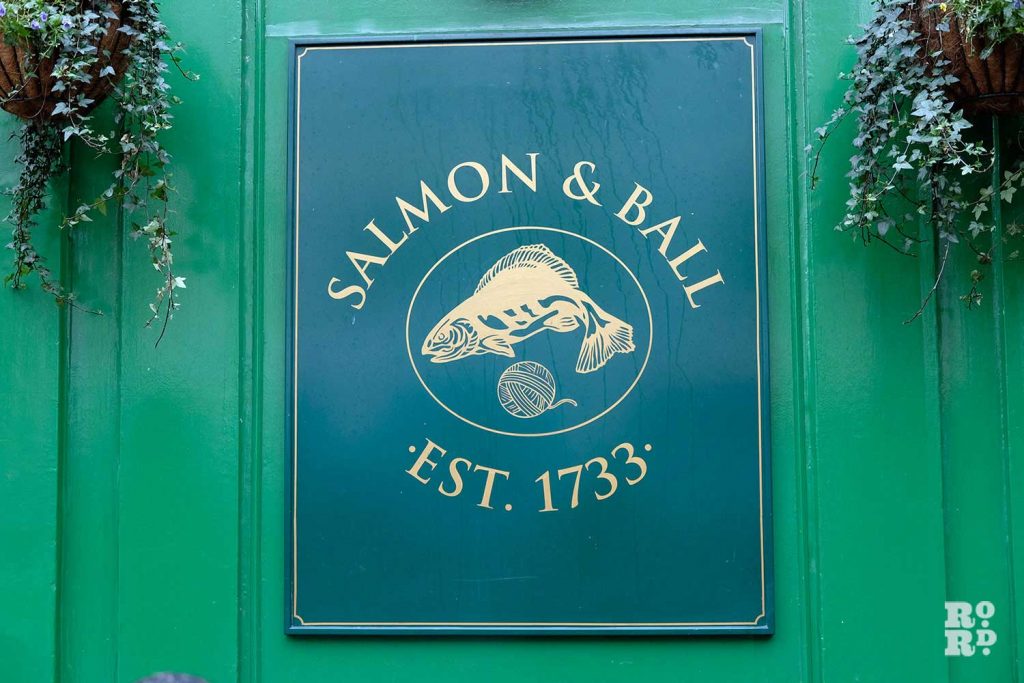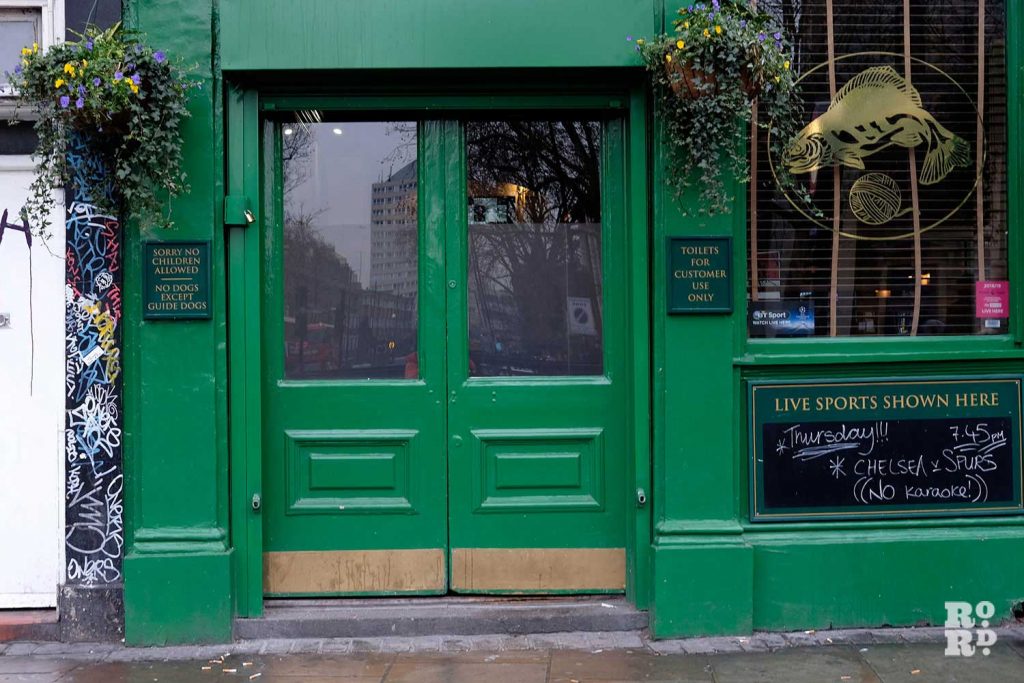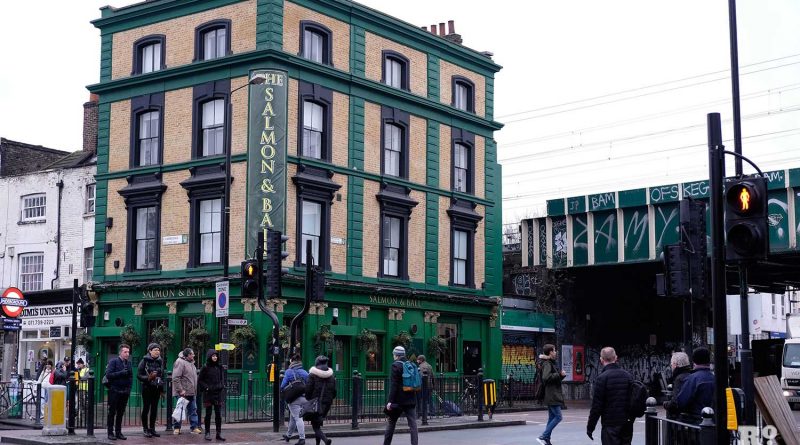The mystery of Salmon & Ball pub
Like every good pub, Salmon & Ball has just a bit of mystery, a little macabre and some great beer. The Grade II listed building sits on the junction between Bethnal Green Road and Cambridge Heath Road, and unmissable with its green glossy exterior, proudly adorns a sign saying, ‘est. 1733’.
Salmon & Ball has borne witness to the vibrant east end for almost 290 years, and yet no one even knows for certain why it’s called ‘Salmon & Ball’. A google search only gets you to TripAdvisor. After rummaging through the Tower Hamlets Archives and talking with Lawrence Camp over the bar, here’s what could be found…
The name game: Salmon and what?
What’s in a name? For Salmon & Ball the jury is still out. Shrouded in mystery, no one can say with 100% certainty why it’s called something so distinct and almost random. Lawrence Camp, who works at the pub, thinks the name alludes to the rich Spitalfields and Bethnal Green silk-weaving history of the late 18th century. This popular theory is that the ‘salmon’ relates to the old Billingsgate fish markets, and the ‘ball’ is a ball of yarn alluding to Weaver’s fields located behind the pub. Therefore, Salmon & Ball was named after the local trades that surrounded it. With Weaver’s fields being where the weavers cottages for the Huguenot silk weaving industry were, and being so close-by, it does sound likely. Yet Billingsgate market would have been quite far away to be half of its namesake.
Others aren’t so convinced by this theory. In an East London magazine from 1891, stumbled on at the archives, one writer suggests that the ball wasn’t even originally a ball, but ‘a sphere like the annulet of Mr. Elton’s arms. Salmon & Ball would be in this case, a half-way house between the north-eastern gate and Mr. Elton’s residence’. We might assume that this is referring to Mr. Thomas Elton of Stratford-le-Bow, a gentleman who is linked to a poem on the church St. Dunstan’s in Stepney. In this case, it might be that the stone carving has worn down and lost its actual heraldic meaning. However, who this mysterious Elton is, and why it would bear his annulet remains unclear.
In the East London Advertiser, 8 March 1991, David Keen wrote that its name came from the weaving industry too, ‘the ball was the emblem of Constantine the Great and silk-weavers adopted this sign because silk came from the east,’ and ‘Salmon’ was simply because of the belief that it could be caught in the River Thames.
Whatever the name, it underwent a swift ill-thought out change for 13 years from 1978, being called ‘Tipples’ for a time. Locals thought this created the image of stumbling drunkards at the end of the night and hated it. The locals fought against this name of their beloved pub and eventually the original name was restored by Norman Ceurvals in 1991.
Some mystery, some history and a little bit of murder
Salmon & Ball has borne witness to the macabre through the years, starting with a hanging on its doorstep in December 1769. John Doyle and John Valline were two weavers arrested for being involved in a secret meeting, something akin to a union today, of riotous weavers at the ‘Dolphin’ pub in Spitalfields. They were accused of being ‘cutters’. ‘Cutters’ were people that, concerned others were pulling down the rate of pay, destroyed the work of weavers who accepted a lower rate of pay for their services or the work of masters who didn’t pay an acceptable wage. In the thick of the Spitalfields riots, the pair were convicted on evidence provided by two other weavers, and were hanged publicly right outside the Salmon and Ball. Both declared until death that they were innocent. It was later revealed that the evidence against them was given falsely and the witnesses had been bribed by a master weaver.
Salmon & Ball not only had a public hanging practically on their welcome mat, it was also outside the pub that Oswald Mosley, of the British Union of Fascists, is recorded to have given some of his harangues in the 1930s. The fascist group often met in the pub and Victoria Park, threatening hecklers with violence.
Another rather bizarre twist of bad luck came in 1970, when the Salmon & Ball owner Terry Sully was kidnapped and robbed of £8,600 from the pub. Rather unluckily, a short month later the top floor of the building was on fire. The Salmon and Ball turned it back around though, with £20,000 in renovations, and a complete switch up in style and audience in 1974. The pub went from disco vibes and dancing, to the over 25s and an air of comfort.
A happier note
Despite some of the chaos that 18th century east end had brought, the Salmon & Ball pub has made it through. It’s also known for a few other, happier, events. It was an occasional meeting place for the Bethnal Green Philanthropic Pensioners society, founded by subscribers in 1822. They were recorded in the Parliamentary Papers from the H.M. Stationery Office as having established there in 1833, and were also recorded to have met again there in 1841. Before occupational pensions, the retired would struggle to cope. The Philanthropic Pensioners society wanted to change that, and had subscribers who would donate to the elderly weekly. They would decide collectively, through weekly polls, who would receive the donations.
The Salmon and Ball pub was quite a trendy place back before its change of style in 1974 and was often the first to embrace new things. It was one of the first places in the east end to get a licence to play music in 1840. Later, it advertised that it was the only saloon bar with ‘real Victorian style gas-lamps’ in 1971, and was known for having beautiful barmaids, disco music and ‘dolly go-go dancers’ in the sixties. According to Lawrence Camp, the upstairs of Salmon & Ball used to be a boxing area instead of residential around the fifties too.
Still a little hazy
Salmon & Ball remains a kind of enigma, with years of its history drawing a blank in the archives and in newspapers. If you can help with any additional research to fill in the gaps, please use the comments below and we’ll update the feature accordingly.
If you want to pop into Salmon & Ball for a pint, it’s where it’s always been, on 502 Bethnal Green Road
If you enjoyed this article, you might also like our article about the Bethnal Green Stairway to Heaven or the Bethnal Green Library.




